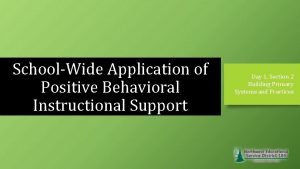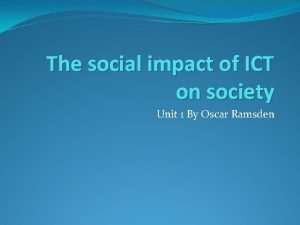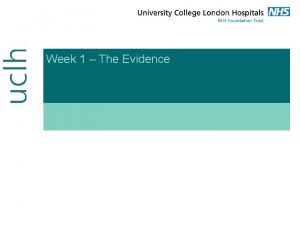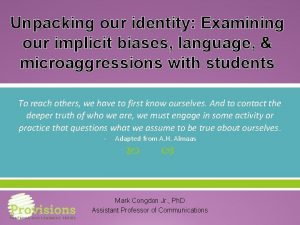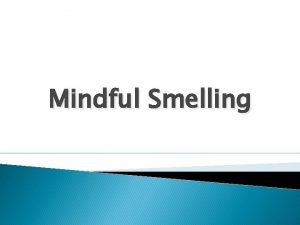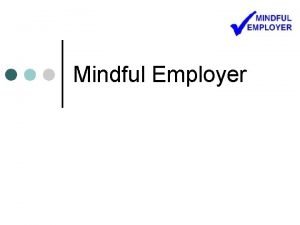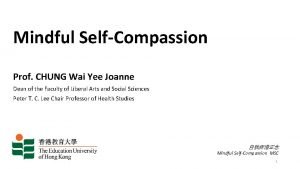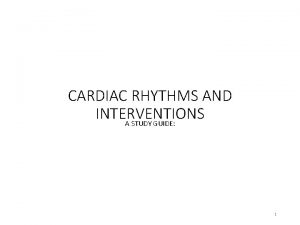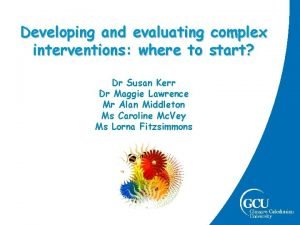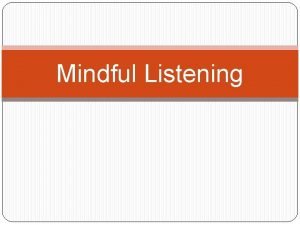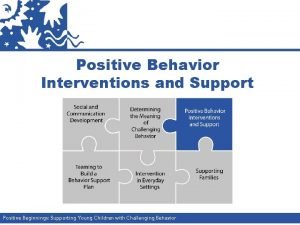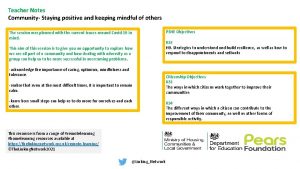MINDFUL AND POSITIVE LEADERSHIP INTERVENTIONS IMPACTS ON POSITIVE




























- Slides: 28

MINDFUL AND POSITIVE LEADERSHIP INTERVENTIONS: IMPACTS ON POSITIVE EXPERIENCES, TRAITS AND BEHAVIORS British Academy of Management 2020

Dr. Laurent GIRAUD Associate Professor Toulouse School of Management TSM-Research (UMR CNRS 5303) Dr. Soufyane FRIMOUSSE Associate Professor IAE of Corsica Yves LE BIHAN French Institute for Positive Leadership Members of the ESSEC Chair of Change Management GIRAUD et al. – BAM 2020

Mindfulness = "being attentive and aware of what is happening in the present moment". (Brown & Ryan, 2003, p. 822). Acceptance/engagement therapy that accompanies individuals through the reinforcement of psychological, emotional and behavioural flexibility. (Desmarais, 2017; Hayes et al. , 2006). "A fully conscious leader. . . will have a better understanding of events and be more competent to lead his team. " (Autissier et al. 2015, p. 216). This attentive capacity facilitates the management of multiple solicitations/emergencies. (Shapiro et al. , 2006). GIRAUD et al. – BAM 2020

Positive Psychology "The study of conditions/processes that contribute to the optimal development/functioning of individuals, groups and institutions". (Gable & Haidt, 2005) Takes into account the human person not only as an individual, but also as a being in relationship with others, inserted in a social fabric. GIRAUD et al. – BAM 2020

Interest of our study Conceptualizations of mindfulness used in Management Sciences sometimes far from its Buddhist meaning (i. e. fulfillment). (Purser & Milillo, 2014) The concept of Positive Leadership seeks to: Contribute to efforts to conceptualize mindfulness, Identify the characteristics of a good leader by using : to mindfulness, neuroscience but also positive psychology! Measuring self-transformation as a leader. A necessary step in the transformation of employees and then of organizations. GIRAUD et al. – BAM 2020

One of the priorities for a leader is to "do no harm" when practicing leadership. (Stavros & Galloway, 2010, p. 136). Showing compassion/empathy would then be essential for a good leader. Research question: We investigate the effects of a leadership-focused Positive Psychology Intervention (PPI) on positive experiences, traits and behaviors as perceived by managers and employees. Indeed, a mix between a PPI and a focus on Positive Leadership (Malinga et al. , 2019) is likely to yield even stronger effects on positive traits, experiences and behaviors.

Research Model Manager level Employee level Positive Psychology Intervention focused on mindful and positive leadership Positive Leadership • Generosity • Empathy • Mindfulness • Inspiration • Collective meaning • Resonance H 1 H 4 H 2 Perceived stress H 3 Organizational Citizenship Behaviors • Altruism • Mutual assistance • Civic virtues • Team spirit Perception of organizational justice • Distributive • Procedural • Interpersonal GIRAUD et al. – BAM 2020

Psychometric properties of measurement scales Measured variable Number of items Validity confirmed Reliability 4 5 5 4 Yes Yes Yes Cronbach’s α = 0. 88 Cronbach’s α = 0. 91 Cronbach’s α = 0. 93 Cronbach’s α = 0. 89 Cronbach’s α = 0. 87 Cronbach’s α = 0. 85 4 7 4 5 Yes Yes Cronbach’s α = 0. 96 Cronbach’s α = 0. 88 2 4 4 3 Yes Yes Cronbach’s α = 0. 75 Cronbach’s α = 0. 72 Cronbach’s α = 0. 75 Cronbach’s α = 0. 70 10 Yes Cronbach’s α = 0. 88 Positive Leader (Frimousse et al. , 2017) Generosity Empathy Mindfulness Inspiration Collective meaning Consonance Organizational justice (Colquitt, 2001) Distributive justice Procedural justice Interactional justice Interpersonal justice Organizational Citizenship Behaviors (Paillé, 2006) Altruism Mutual assistance Organizational civic virtues Team spirit Perceived Stress Scale (Cohen et al. , 1983) GIRAUD et al. – BAM 2020

Positive Leadership dimensions (Frimousse et al. , 2017) 1. Altruism-generosity Corresponds to the ability to help others. 2. Compassion-empathy It refers to the ability to perceive/recognize and be in solidarity with the suffering/pain/emotions of others. 3. Consciousness-attention Focusing one's full attention in the moment, without judgment, on oneself, on others and on the environment. GIRAUD et al. – BAM 2020

The Leader+. 4. Influence-inspiration Emphasizes the ability to convince, coach, inspire others positively. 5. Collective Hope Gather the power to propose a purpose to others and to function in mutual aid. 6. Consonance-resonance Indicates the ability to act authentically according to one's strengths and values. GIRAUD et al. – BAM 2020

Field of study SANOFI (Vaccines Division) Data collected in 2016 R&D Department (3500 employees + 600 managers). Training programme for managers in Positive Leadership (combining positive psychology and mindfulness meditation) is underway. GIRAUD et al. – BAM 2020

The PPI consists in training sessions of 1 h 30 per week during four months for managers and employees. Studied sample Data were collected just before (T 1) and just after (T 2) the PPI. GIRAUD et al. – BAM 2020

Illustrative measurement items Likert scale on 6 points. 1. Compassion/Empathy (Leader+) Frimousse et al. (2017) 1. My manager would be the first person I would consult in 2. 3. 4. 5. case of great difficulty. It helps me manage my emotions. He's good at helping me deal with my emotions. He could help me get over my difficult emotions. He's being compassionate with me. GIRAUD et al. – BAM 2020

Illustrative measurement items 2. Interpersonal Justice (Colquitt, 2001) "My manager treats me politely. " 3. Recognition at work by the superior (Fall, 2015) "My superiors give words of encouragement when I'm facing a difficult situation. " 4. Well-being (relationship to others) (Biétry & Creusier, 2013) "I have good relations with my colleagues". GIRAUD et al. – BAM 2020

Results Significant changes in mean scores for managers (standard deviation). T-tests compared to the previous time period (* = p<0. 05; ** = p<0. 01; *** = p<0. 001). PLX managers (38 in T 1, 36 in T 2) T 1 Empathy Mindfulness Consonance Perceived Stress 4. 37 (0. 44) 4. 35 (0. 60) 4. 23 (0. 51) 3. 33 (0. 65) T 2 4. 62 (0. 48)*** 4. 59 (0. 48)* 4. 65 (0. 49)*** 2. 76 (0. 62)*** Control group (26 in T 1, 25 in T 2) T 1 T 2 4. 47 4. 49 (0. 50) (0. 60) 4. 45 4. 62 (0. 52) (0. 58) 4. 39 4. 30 (0. 43) (0. 48) 3. 03 2. 81 (0. 63) (0. 53) Employees with PLX managers Significant changes in mean scores for employees (standard deviation indicated in parentheses). T-tests compared to the previous wave (* = p<0. 05; ** = p<0. 01). (54 in T 1, 49 in T 2) T 1 T 2 Mindfulnes s Collective meaning Procedural justice Organizati onal civic virtues 3. 89 (0. 94) 4. 37 (1. 06)** 4. 30 (1. 03) 4. 68 (0. 80)* 3. 31 (0. 73) 3. 68 (0. 68)** 3. 37 (0. 75) 3. 71 (0. 65)** Control group (55 in T 1, 46 in T 2) T 1 4. 19 (0. 87) 4. 62 (0. 70) 3. 46 (0. 67) T 2 4. 40 (0. 84) 4. 84 (0. 75) 3. 61 (0. 55) 3. 43 (0. 70) 3. 58 (0. 74)

Results Managers almost fully engaged with the PLX programme. Across the whole 10 -session programme, 80. 7% of managers practiced the mindfulness exercises at least 3 days a week on average. The most representative group practiced them three days a week (34. 6%). 92. 3% of managers practiced the mindfulness meditation exercises for more than five minutes a day on average. The most representative group (30. 8%) practiced them for durations of five to ten minutes. We observe that the PLX programme has a long-lasting impact: once it was over, 61. 4% of managers practiced the mindfulness exercises at least three days a week on average. The most representative group practiced them three to five days a week (57. 6%). GIRAUD et al. – BAM 2020

Results The most effective practices to apply for well-being, according to the 36 PLX managers at T 2 (number of occurrences in answers to a multiple-choice question). Taking a break before or after a meeting Focusing on the positive Mindfulness breathing exercises (3 min) 20 19 18 Being aware of my responses in stressful situations with the employees I manage Emotional/sensorial scan Spreading kindness Mindfulness breathing exercises (10 min) Encouraging mutual help and support Encouraging positive speaking 12 10 10 9 9 8 The most effective practices to improve relationships with teams, according to the 36 PLX managers at T 2 (number of occurrences in answers to a multiple-choice question). Encouraging positive speaking Encouraging mutual help and support Thank-you visits to team members Focusing on the positive Being aware of my responses in stressful situations with the employees I manage Spreading kindness Mindfulness breathing exercises (3 min) Writing down 3 positive experiences a day Keeping a gratitude journal GIRAUD et al. – BAM 2020 17 17 16 14 12 12 8 8 8

Discussion We first confirm the PPI under study develop the positive traits of the managers (H 1 confirmed). Indeed, our results suggest that a Positive Psychology Intervention increased: (1) the managers’ empathy and consonance (according to the managers themselves), (2) the manager’s collective meaning (according to the managers again) (3) the managers’ mindfulness (according to both the employees and the managers). Moreover, our study identifies the positive psychology and mindful operational exercises that managers seem to particularly appreciate whether it is for their own well-being or for a better team functioning. The sustainable use of those positive psychology and mindfulness exercises confirms that they are synonymous with positive experiences (Chong et al. , in press).

Discussion Our study also suggests that PPIs increase the positive experiences: Indeed, managers who were subject to the PLX intervention did master their stress better afterwards (H 2 confirmed). This result contributes to the evolution of the stress literature which is now more oriented towards work tensions and burnout (Bliese et al. , 2017). We confirm that the PPI is a useful tool to improve mental health and well-being (Donaldson et al. , 2015; Rashid, 2015), especially when combined with MBI and regarding the management of stress (Eby et al. , 2019).

Discussion Our work shows that the development of positive traits of the manager is associated with more positive experiences and behaviors from the employees’ side. Our results show that employees’ perception of procedural justice increases with a PLX manager (H 3 confirmed), parallelly to a similar increase in the display of civic virtues (a dimension of OCB – H 4 confirmed). Therefore, we suggest that mindfulness provides managers with a better grasp of their feelings and those of the people working with them, and this serves to improve perception of procedural justice for instance. The associated increase in both perception of procedural justice and the display of civic virtues would corroborate Colquitt et al. (2012)’s idea that justice is a key factor in organizational performance. GIRAUD et al. – BAM 2020

Discussion The characteristics/development of a good leader goes beyond the professional sphere. (Hammond et al. , 2016). We confirm the work of spiritual leadership practitioners for whom "transformational leadership has a virtuous framework ". (Voynnet Fourboul, 2016, p. 123). GIRAUD et al. – BAM 2020

Empirical contributions Our article first provides an empirical contribution by successfully testing the validity and the reliability of the Positive Leader measurement scale (Frimousse et al. , 2017). Second, we bring longitudinal data collected over four months showing that the effects of a Positive Psychology Intervention are long-lasting, both for employees and managers. Thirdly, we provide a quasi-experimentation which has somehow been lacking to the management literature (Grant & Wall, 2009). Eventually, we bring data from the French territory which was somehow missing in the field of positive psychology even though it is expanding globally (Hendriks et al. , 2019, p. 3). GIRAUD et al. – BAM 2020

Theoretical contributions First, the present application of the Positive Leadership scale (Frimousse et al. , 2017) illustrates the growing interest by academics and practitioners in a spiritual (Spector, 2014) and positive (Caza & Cameron, 2008) approach to leadership. It contributes to the Positive Organizational Scholarship (Caza & Cameron, 2008) by proposing a measurement scale for Positive Leadership. In the meantime, our study shows that Positive Leadership has a significant impact on employee attitudes in terms of perception of justice and organizational civic virtues (Fischer et al. , 2017). Second, our research contributes to theoretical models of Positive Organizational Scholarship (Caza & Cameron, 2008) by suggesting that a leadership-focused PPI impact both managers and employees. We parallelly contribute to the literature on empathy which still deserves further investigation (Clark et al. , 2019).

Managerial contributions Firstly, our results suggest that it would be in firms’ interests to introduce interventions in positive and mindful leadership (Kets de Vries, 2014). More generally, our research encourages to rethink the initial training and continuing professional development of leaders through positive psychology and contemplative practices such as mindfulness meditation (Hafenbrack, 2017). Secondly, our study details the positive psychology and mindful exercises that managers seem to appreciate the most whether it is for their own well-being or for a better team functioning. Other companies can therefore easily and practically be inspired to implement similar positive interventions to improve performance (Cameron et al. , 2011). GIRAUD et al. – BAM 2020

Limits Limited sample size. Primary data from a single source = common method bias. Except from the data on Positive Leadership GIRAUD et al. – BAM 2020

Perspectives Our study first suggests that future inquiry should focus on Positive Leadership (Malinga et al. , 2019) as a promising field of investigation. A test in other settings would here be welcome as organizational and national cultures may interfere with the PPIs and its conceptualization itself (Malinga et al. , 2019). Future research on leadership-focused PPIs could also explore the possible individual differences in their effects (Antoine et al. , 2018). Another suggestion would be to compare objective performance data (sales revenues, productivity, staff turnover, absenteeism, commitment and satisfaction at work, etc) with perceived behavioral changes in Positive Leadership traits and behaviors or measuring the links between the traits and behaviors of the Positive Leader (Malinga et al. , 2019). GIRAUD et al. – BAM 2020

Perspectives Furthermore, it seems necessary to understand why only managers’ mindfulness was identified as improved from both the managers and their employees. On the opposite, evolutions in empathy, consonance and collective meaning were spotted from only one of the two sides. Additional testing of the Positive Leadership scale (Frimousse et al. , 2017) seems to also be required to confirm its full relevance. Finally, future research could focus on possible Collective Positive Leadership like Yu and Zellmer-Bruhn (2018) conceptualized team mindfulness. GIRAUD et al. – BAM 2020

Thank you for your attention laurent. giraud@iae-toulouse. fr
 Materials technology negative impacts
Materials technology negative impacts Positive and negative impacts of materials technology
Positive and negative impacts of materials technology Positive impacts of materials technology
Positive impacts of materials technology Positive behavioral interventions and supports
Positive behavioral interventions and supports Positive behavioral interventions and supports
Positive behavioral interventions and supports Positive effects of communication
Positive effects of communication Positive impacts of tourism in glasgow
Positive impacts of tourism in glasgow Positive impacts of information technology
Positive impacts of information technology Social impact of ict
Social impact of ict Negative impact of logging
Negative impact of logging Mindful nation uk
Mindful nation uk Space2 model of mindful inclusion
Space2 model of mindful inclusion Mindful smelling
Mindful smelling The way of mindful education
The way of mindful education Radnor high school grading scale
Radnor high school grading scale Naviance radnor
Naviance radnor What is mindful speech
What is mindful speech Mindful moment
Mindful moment Mindful employer
Mindful employer Mindful listening key skills
Mindful listening key skills Joanne chung wai yee
Joanne chung wai yee Transactional leadership and transformational leadership
Transactional leadership and transformational leadership Nsf grfp results
Nsf grfp results Adaptive management style
Adaptive management style Enthusiastic beginner disillusioned learner
Enthusiastic beginner disillusioned learner Jones and bartlett ekg strips 2012
Jones and bartlett ekg strips 2012 Developing and evaluating complex interventions
Developing and evaluating complex interventions Dementia treatments and interventions near patterson
Dementia treatments and interventions near patterson Negative social impacts of tourism
Negative social impacts of tourism



